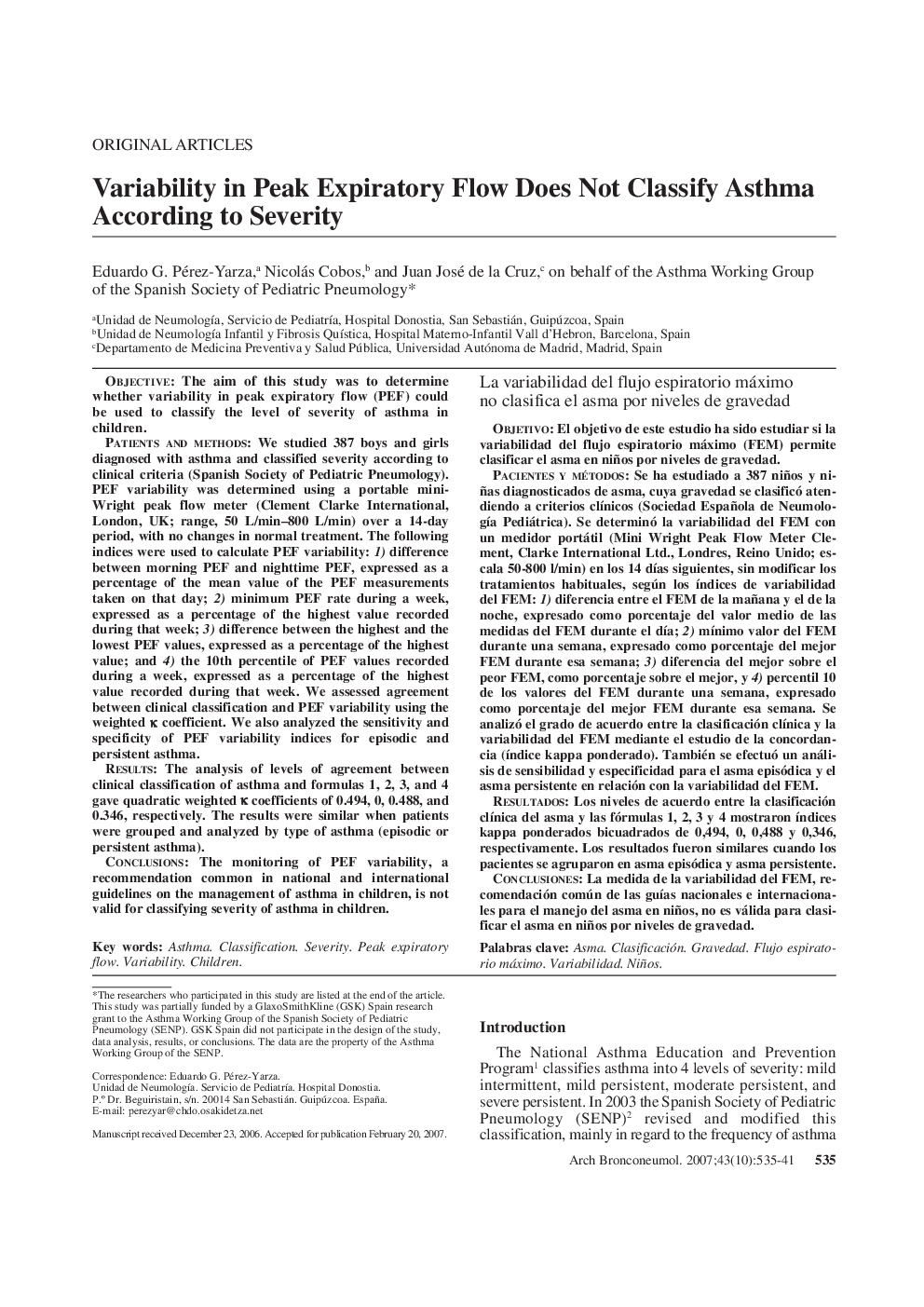| Article ID | Journal | Published Year | Pages | File Type |
|---|---|---|---|---|
| 4206620 | Archivos de Bronconeumología (English Edition) | 2007 | 7 Pages |
ObjectiveThe aim of this study was to determine whether variability in peak expiratory flow (PEF) could be used to classify the level of severity of asthma in children.PATIENTS AND METHODSWe studied 387 boys and girls diagnosed with asthma and classified severity according to clinical criteria (Spanish Society of Pediatric Pneumology). PEF variability was determined using a portable mini- Wright peak flow meter (Clement Clarke International, London, UK; range, 50 L/min–800 L/min) over a 14-day period, with no changes in normal treatment. The following indices were used to calculate PEF variability: 1) difference between morning PEF and nighttime PEF, expressed as a percentage of the mean value of the PEF measurements taken on that day; 2) minimum PEF rate during a week, expressed as a percentage of the highest value recorded during that week; 3) difference between the highest and the lowest PEF values, expressed as a percentage of the highest value; and 4) the 10th percentile of PEF values recorded during a week, expressed as a percentage of the highest value recorded during that week. We assessed agreement between clinical classification and PEF variability using the weighted [.kappa] coefficient. We also analyzed the sensitivity and specificity of PEF variability indices for episodic and persistent asthma.RESULTSThe analysis of levels of agreement between clinical classification of asthma and formulas 1, 2, 3, and 4 gave quadratic weighted κ coefficients of 0.494, 0, 0.488, and 0.346, respectively. The results were similar when patients were grouped and analyzed by type of asthma (episodic or persistent asthma).CONCLUSIONSThe monitoring of PEF variability, a recommendation common in national and international guidelines on the management of asthma in children, is not valid for classifying severity of asthma in children.
ObjetivoEl objetivo de este estudio ha sido estudiar si la variabilidad del flujo espiratorio máximo (FEM) permite clasificar el asma en niños por niveles de gravedad.PACIENTES Y MÉTODOSSe ha estudiado a 387 niños y niñas diagnosticados de asma, cuya gravedad se clasificó atendiendo a criterios clínicos (Sociedad Española de Neumología Pediátrica). Se determinó la variabilidad del FEM con un medidor portátil (Mini Wright Peak Flow Meter Clement, Clarke International Ltd., Londres, Reino Unido; escala 50-800 l/min) en los 14 días siguientes, sin modificar los tratamientos habituales, según los índices de variabilidad del FEM: 1) diferencia entre el FEM de la mañana y el de la noche, expresado como porcentaje del valor medio de las medidas del FEM durante el día; 2) mínimo valor del FEM durante una semana, expresado como porcentaje del mejor FEM durante esa semana; 3) diferencia del mejor sobre el peor FEM, como porcentaje sobre el mejor, y 4) percentil 10 de los valores del FEM durante una semana, expresado como porcentaje del mejor FEM durante esa semana. Se analizó el grado de acuerdo entre la clasificación clínica y la variabilidad del FEM mediante el estudio de la concordancia (índice kappa ponderado). También se efectuó un análisis de sensibilidad y especificidad para el asma episódica y el asma persistente en relación con la variabilidad del FEM.RESULTADOSLos niveles de acuerdo entre la clasificación clínica del asma y las fórmulas 1, 2, 3 y 4 mostraron índices kappa ponderados bicuadrados de 0,494, 0, 0,488 y 0,346, respectivamente. Los resultados fueron similares cuando los pacientes se agruparon en asma episódica y asma persistente.CONCLUSIONESLa medida de la variabilidad del FEM, recomendación común de las guías nacionales e internacionales para el manejo del asma en niños, no es válida para clasificar el asma en niños por niveles de gravedad.
